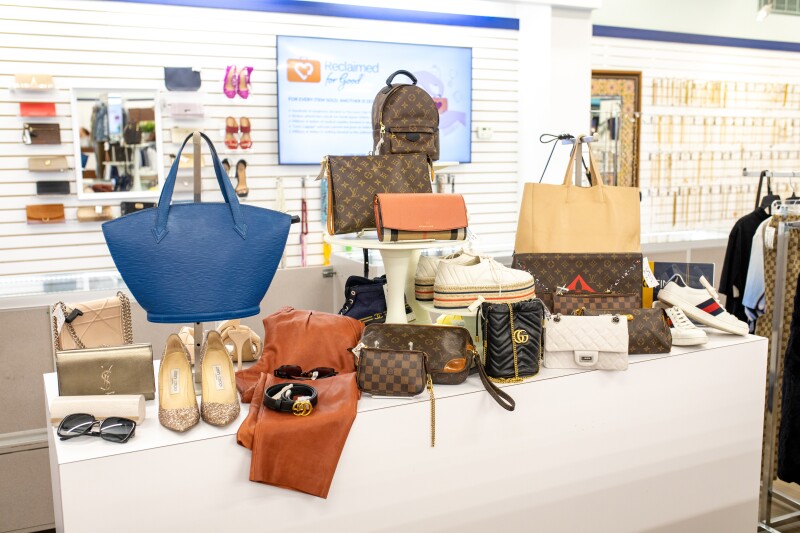There are few moments in the travel experience more disheartening than watching the baggage carousel come to a halt and realizing your suitcase didn’t make it to your destination. At best, it’s a hiccup in your plans, and at worst, you could lose the suitcase and its contents forever.
In 2022, some 26 million bags were mishandled (meaning delayed, damaged, lost, or stolen) worldwide, according to SITA, an IT provider for the air transport industry. That equates to roughly 7.6 bags out of every 1,000 passengers—a number that has been increasing since the onset of the pandemic, partly due to staffing shortages.
While most of those bags eventually make it back to their owners, about 7 percent (or 1.8 million) are completely lost worldwide each year. That can happen for any number of reasons: a damaged or lost tag, a technology glitch, or human error, such as an agent typing in the wrong airport code.
How bags become unclaimed in the first place
When an airline passenger checks a bag, the agent will put a barcode sticker on it for tracking. This code contains a lot of information, including your destination, time of departure, an International Air Transportation Association (IATA) airport code, your flight number, and your first and last name. If the bag is then lost, the airline can use the barcode to trace where the item was last scanned.
Sometimes, though, it may not be able to find the bag in the expected location, and in those cases, the airline will take additional measures. For example, Amy Fisher, a consumer public relations manager at United, explains that her company will solicit further details from the owner. “We inventory the bag, and we also ask the passenger to fill out a detailed claim form with the content,” she says. “We use software to match the information from all the airlines’ inventory efforts to the description of the passenger and find the bag.”
To help with all of this, many airlines use WorldTracer, a third-party tracing and matching system owned by SITA, for reporting lost bags and reuniting them with their owners.
The IATA requires airlines to hold onto bags for a minimum of 90 days. If the airline is unable to reunite a bag with its owner, the airline throws in the towel and reimburses the owner, up to $3,800, as mandated by the Department of Transportation. To get that money, though, you may need to submit receipts for the items in the bag.
Even if your bag is merely delayed, you may be able to get some payback. Both Delta and Alaska have 20-minute guarantees: If your bag doesn’t come out of the carousel within that time frame, Delta will give you miles and Alaska will give you miles or a travel credit.

As truckloads of luggage arrive at Unclaimed Baggage, the staff sorts through all the contents, clearing electronics of personal data and sending clothing to the largest dry cleaner in Alabama.
Courtesy of Unclaimed Baggage
Where does unclaimed baggage go?
After a piece of mystery luggage has been sitting for more than three months in a storage facility, the airline is allowed to get rid of it. In the USA, much of it is sent to Unclaimed Baggage, a retail warehouse in Scottsboro, Alabama. Items forgotten at security checkpoints, left in overhead bins or seat-back pockets, or abandoned by fliers at the airport to meet weight requirements also typically end up at Unclaimed Baggage.
“The airlines have a great success rate in reuniting bags with their owners, but even a fraction of a percent of all lost bags adds up quickly when one considers that millions of people travel every day, and Unclaimed Baggage is the only company in the nation which [sorts and repurposes lost luggage],” said Sonni Hood, a public relations manager at the 53-year-old company. “Once the airlines have conducted the 90-day baggage tracing process, Unclaimed Baggage steps in as a salvage partner to the airlines and purchases the bags sight-unseen, helping to keep millions of items out of a landfill each year.”
At the 50,000-square-foot shop, all the sundry items from people’s luggage (anything from underwear and cosmetics to electronics and ski equipment) are sorted. Items that the company deems sellable are professionally cleaned and sold at 50 to 80 percent off the retail price, even on high-end goods. And there are some good finds. For instance, when director Daniel Scheinert won three Oscars for Everything Everywhere All at Once, he was wearing a tux he bought here.
Only about a third of the items that arrive here end up on the racks; some aren’t in new enough condition or, according to Unclaimed Baggage, are illegal to sell, like ivory or shrunken heads (which have been found multiple times each). Still, the store restocks with more than 7,000 new items every day, and more than 1 million people visit yearly. The destination is so popular that in 2020, for the company’s 50th anniversary, Unclaimed Baggage finally launched an online store for treasure hunters across the country.
Anything that isn’t put out for sale is recycled or donated to charities that work with those in need.
“Unclaimed Baggage’s goal is to give new life to each item inside lost luggage and to redeem them for good,” Hood said, adding that the company’s charitable foundation, Reclaimed for Good, donates suitcases to foster children, prescription eyeglasses to the Lions Club, wheelchairs and other mobility devices to Wheels for the World, and clothing to homeless shelters.
While it’s never fun to lose your luggage, you can take some small solace in knowing it won’t go to waste and may be used by someone who really needs it.








